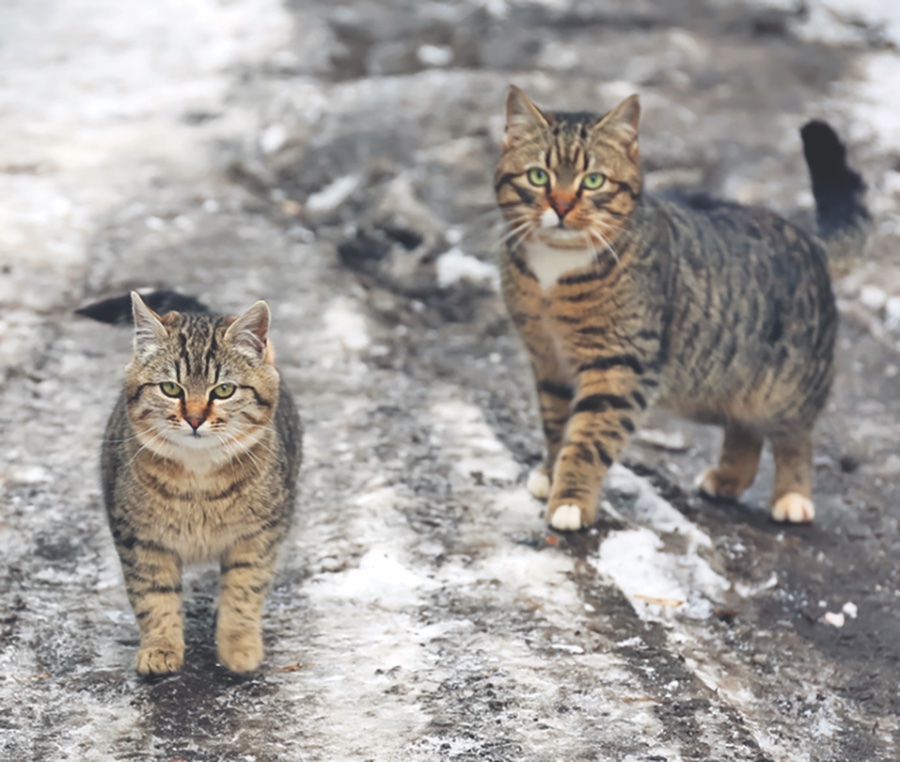Many feral cats living in our neighborhoods are doing just fine and don’t need our help. But once in a while a sick or injured cat may benefit from some human assistance. It’s important to understand the difference.
Is It Really Feral?
Just because a cat is hanging out outside does not mean it is necesarily feral. There are three groups of cats you might see outside:
- Owned cats who are allowed outside
- Stray cats who were once cared for by humans but have run away from home or have been abandoned
True feral cats
A feral cat is “an adult feline that lives outdoors and is not socialized with people, much like a wild raccoon or weasel,” says Lena DeTar, DVM, a board-certified shelter medicine veterinarian and the interim director of Maddie’s Shelter Medicine Program at Cornell University’s College of Veterinary Medicine.
The key detail is that feral cats act like wild animals and want nothing to do with people. “If the cat comes up to you and solicits attention, it likely isn’t feral and likely belongs to a neighbor,” says Dr. DeTar. “There are many creative ways to determine this, such as attaching a small note with your phone number to its collar. Children are often great sources of local neighborhood information . . . and probably know whose cat it is.”
Assess Status
“If a feral cat looks like it is doing well and has an ear tip (a flat top of the pointy part of the ear usually on the left side in this part of the country) indicating it has been spayed or neutered and vaccinated, leaving it be is the best policy!” says Dr. DeTar.
A healthy feral cat will have a clean, shiny coat and move easily, most likely running away from you at high speed. These cats are often lean, but not emaciated with bones easily visible, and are generally healthy.
Spay and Neuter
“If the unsocialized feral cat looks healthy but has two normal-looking ears, we recommend borrowing a humane cat trap and working with a local shelter or spay-neuter program to make a plan to get it fixed,” says Dr. DeTar.
Two resources for learning how to trap feral cats are:
- Kitten Lady Hannah Shaw https://www.youtube.com/watch?v=wF_omFE7Etc
- Ally Cat Allies https://www.alleycat.org/community-cat-care/steps-for-a-successful-trapping-day/
Don’t dive into trapping a feral cat until you have a plan in place for its care.
“Shelters may have a waiting list, so always call ahead before trapping,” says Dr. DeTar. Veterinary clinics also usually require an appointment ahead of time and may not be able to accommodate “surprise” feral cats in need of a sterilization procedure or other care, and you will be responsible for the bill.
Trap-neuter-release can be a process, but it is worth the effort. “Trapping allows the cat to have a veterinary exam while sedated, to make sure it doesn’t have any medical problems that can be addressed and improves its health through vaccination and spay-neuter,” says Dr. DeTar. “Sterilizing cats prevents risky activities associated with being intact such as crossing roads to chase other cats, cat fights, sexually transmitted diseases, pregnancy, giving birth, and nuisance behaviors such as urine spraying. Spaying or neutering this one also helps decrease the population of feral cats in your neighborhood!”
Sick or Injured Cats
“If a feral or stray cat is very sick or seriously injured, call your local shelter or rescue group. If they have the capacity to help, they will. Some local veterinarians are also willing to help if you can get the cat into a trap, though there may be charges associated with the cat’s care. As with injured wildlife, sometimes euthanasia is the kindest solution for feral cats in distress,” says Dr. DeTar.
What Not to Do
Other than providing basic care for healthy cats and care for sick or injured cats, it is usually best to let feral cats live their own lives.
“Unless you plan to start to manage a whole colony of feral cats, it is generally not a good idea to start feeding them.” Says Dr. DeTar. “Putting food out draws more cats and other wildlife that can include rabies vectors; a new cat in the area will keep travelling on if it can’t find food.” Save your spare cat food for when you need to trap a feral cat for care.
“Dropping the cat off at the local shelter is also not appropriate. Shelters cannot provide humane care for these wild animals,” says Dr. DeTar. “This is true even in winter. The reason we have so many cats around is that they are good at finding ways to survive and thrive even in our cold climate. If concerned about outdoor cats in cold weather, providing a small feral cat house can help.”
Bottom Line
Truly feral cats behave like wildlife, avoiding human contact and thriving on their own. “If the cat looks healthy and uninjured, it’s probably doing just fine where it is,” says Dr. DeTar.
Lena DeTar, DVM, is a board-certified shelter-medicine veterinarian and the interim director of Maddie’s Shelter Medicine Program at Cornell University’s College of Veterinary Medicine.




